Zamioculcas flower: how to care for and transplant a plant?
Zamioculcas - a plant that interestingly fits into the interior of any room or office. It has a second name - the dollar tree. Its appearance, creating coziness and warmth in the room. In order to properly care for a handsome man, it is recommended to know all the rules and nuances of growing it. Therefore, it is worth reading all the recommendations and only then purchasing a green pet.
Content
- Indoor plant description
- Watering and feeding
- Plant capacity and soil
- Lighting, humidity and temperature
- Transplant terms and rules
- Diseases, their signs and the fight against them
- Pests, their signs and control of them
Indoor plant description
The shrub comes from the Aroid family, stands out from the monotypic genus. His family is represented in a single copy - by the dollar tree itself. Its first origin was seen in the desert expanses of Africa. In these regions, the shrub grows on an equal footing with other succulents. They are endowed with the ability to withstand a strong rise in temperature and the baking rays of the sun. In this case, the structure of the sheet is made in such a way that moisture is retained for a long period in the core of the sheet plate, and does not evaporate under the influence of heat.
Zamioculcas is endowed with a well-branched root system.
At the base of the rhizomes, there is a central root with many small adventitious. In botany, such rhizomes are distinguished into a separate subtype called a tuber. The foliage of the shrub is represented by small oval leaf plates, which in wildlife can grow up to 1 m in length. The foliage has a complex feathery structure, while it has a glossy surface and the same size for each of the leaves. The upper surface of the greenery was opened with wax coating. This allows the plant to prevent moisture evaporation and accumulate it faster.
The plant is endowed with an interesting flower - it is both nondescript and enticing with its uniqueness. The inflorescence is presented in the form of a small cob that looks like corn. A coating forms on top of the formation, enveloping an accumulation of small flowers. A flower appears almost at the very base and blooms in such a way that it does not attract much attention.
Watering and feeding
Zamioculcas does not require special care. But if you do not follow minor recommendations for plant maintenance, then the shrub may die. At the same time, the plant initially provokes the discharge of all foliage, and only then the stems and rhizomes begin to die off.
The dollar tree is one of the plant varieties that tolerate long periods of drought well. But if watering is not organized in time, then the bush quickly depletes its own nutritional forces and dies.
In order for the shrub to feel great and grow quickly, periodic watering should be carried out:
- Irrigation is recommended as needed. It is better not to top up the plant than to turn the soil in which it is located into swampy soil.Waterlogging threatens the shrub with the addition of pathogenic bacteria or rotting root system.
- In the summer, irrigation is applied in a moderate type. This is due to the fact that between the introduction of nutrient moisture, a period should be maintained until the top layer of the soil dries up and only then the required volume of liquid should be added.
- In the winter months, moisture is applied even less often - once every 4 weeks. This is enough for the bush to be saturated with water and continue to grow. Watering is carried out with settled water, not cold by degrees, preferably at room degrees.
- Thanks to the wax coating on the foliage of the dollar bush, the dust is quickly attracted and settles on the leaf plate. To eliminate the deficiency, it is recommended that the plant arrange a warm irrigation shower. For this, the bush at the base of the soil is covered with a film and installed under direct streams of water.
Like all houseplants, zamioculcas requires periodic feeding. To implement this event, it is recommended to take a universal top dressing for indoor plants. You can replace universal fertilizers with urea. Dilute the contents to the desired consistency.
The application of nutrient fertilizers should be carried out during the period of active plant growth, with a frequency of 1 time in 14 days. In addition, the plant actively responds to foliar feeding when the nutrient fluid is sprayed over the bush. It should be produced no more than 2 times a month in between watering.
Plant capacity and soil
For planting zamioculcas, no special soil substrate is required. He does not need a specific soil. Any fertile land is suitable for him. A universal succulent soil sold in specialized stores is perfect for planting. If possible, you can prepare the soil yourself. To do this, you will need to collect leafy soil and sod soil, and also add crushed dry peat to the mixture. All components must be mixed in the same proportions.
In addition, it is recommended to add charcoal to the prepared soil substrate to eliminate possible root rot infection.
He will eliminate all disease-causing diseases that provoke ailment. The main thing is to prepare the soil - the soil should be loose and airy. This is necessary so that water easily penetrates into the most remote places and does not stagnate in the soil substrate, without provoking the occurrence of fungal diseases.
A flowerpot for a plant can be chosen of any size, the main thing is that there are holes in the lower cavity for the drain of excess moisture. And also an important point when planting a plant is that it is necessary to lay out a layer of 2-3 cm from the drainage on the bottom. Without this layer, the plant can quickly cease to please its owners.
Lighting, humidity and temperature
When kept indoors, zamioculcas does not reveal specific requirements for humidity. It feels comfortable in rooms with any humidity. Light is the most important requirement for a dollar tree. It is recommended to place the shrub so that it has enough sunlight. Sills on the south side, where the sun is present throughout the day, are ideal for this.
The shrub will not refuse to grow on the northern and eastern windows. But in this case, the leaf plates of the plant will be much smaller than those of those bushes that are located on the southern sides. At the same time, on the north side, by placing a flower pot, it is necessary to reduce watering even less.
In the summer months, the shrub is recommended to be moved to an open terrace or taken out into the fresh air, to a personal plot.
The plant feels great in the summer at a temperature of +22 .. + 30 C. At moments of rest, in winter, you should not reduce the degrees in the room to +10 .. + 12 C.These indicators are critical, at which the plant begins to droop and lose its original beauty. It is imperative to periodically ventilate the room in which the flowerpot is located. But, most importantly, do not set the plant on the cold age stream. Otherwise, you can provoke the disease and death of the exotic.
Transplant terms and rules
When planting a young seedling, it is recommended to transplant as the plant grows:
- Due to the fact that the zamioculcas in the first years of its life is intensively growing, it will be necessary to transplant the shrub annually.
- Upon reaching the age of 3 years, the plant is transshipped once every 2 years.
- And from the 5-7th year, the pot and soil are changed only once every 5 years.
For planting, you need to choose a flowerpot that is 3-5 cm higher than the previous pot. Transplanting a dollar tree is identified as a rather problematic task. Therefore, gardeners are not eager to carry out this procedure often enough.
The main condition for transplanting at the initial purchase is the complete removal of the soil in which the seedling is placed. If the rhizomes turn out to be intertwined, then they should certainly be unraveled. In subsequent years, it is not recommended to subject the root system to such a procedure. The dollar tree is transplanted in a strictly transshipment manner.
In such a situation, the soil should be slightly moistened and removed from the habitat with one lump of earth. Place drainage in the selected container, pour a small layer of fresh soil. Place a sprout with a lump of earth on top of it, and add fresh substrate, slightly tamping the surface. After planting, the plant should be well watered.
Diseases, their signs and the fight against them
A dangerous and not sparing plant disease is root rot. If the zamioculcas is affected by a disease, then soon it completely dies. Disease-causing bacteria develop in most cases due to over-watering of the bush. If the prerequisites for the occurrence of root rot are noticed, it is recommended to significantly reduce watering.
If necessary, remove the shrub from the ground, cut off the damaged areas of the root system, sprinkle them wood ash or activated carbon.
After that, it is worth transplanting the plant into a new soil and a fresh flowerpot. And also spray chemical fungicideprovoking the elimination of the disease-causing process. An effective effect is carried out with the use of Oxychom or Fundazol. In addition to rot, the plant's leaf plates may begin to take on a yellowish tint on young leaves. This process of withering away is not a normal action.
Yellowing may be due to improper lighting, excessively high or, conversely, low temperatures, or the presence of a flowerpot with a flower in a draft during winter ventilation. To eliminate this malaise, proper care of the bush should be carried out and its general condition should be constantly monitored.
Pests, their signs and control of them
Zamioculcas tends to be frequently affected by harmful insects. If the plant is constantly indoors, then parasite infestation can occur through new specimens, recently acquired and not yet treated from pests. You can also purchase those not named by the tenant when the bush is brought out in the summer to an open balcony or to the garden.
The following parasitic individuals are distinguished:
- Spider mite - is located on leaf plates and feeds on bush sap. Such a neighborhood provokes the drying of a large part of the leaf plates. It is possible to influence the elimination of the parasite with the help of a diluted soap solution with nicotine sulfate.
- Aphid - a fairly common parasitic individual. There are different types. With its invasion, it is localized on the underside of the leaf plate and feeds on the sap of the flower.To eliminate it, irrigation of the bush is suitable. chemical insecticide.
- Shield - an insect is called by this name due to the fact that its body is covered with a shield. In a single specimen of the parasite on a bush, it is problematic to notice, but with an increase in the population, small shields attached to the surface are clearly visible on the lower part of the leaves. To remove the pest from the plant, it is recommended to use a tobacco-soap concentrate with the addition of denatured alcohol or kerosene.
In order for the plant to suffer less from the effects of chemical insecticides, it is recommended to constantly monitor its external condition and control the appearance of intruders. With a small population, all parasites can be eliminated manually without resorting to serious methods.
So to grow zamioculcas no serious measures and efforts are required. It is recommended to periodically apply the nutrient fluid, periodically carry out loosening so that the soil remains loose and breathable. And also the general condition should be monitored in order to prevent the growth of pathogenic bacteria and parasitic individuals.
More information can be found in the video:




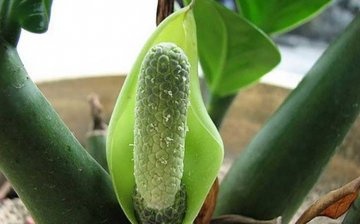
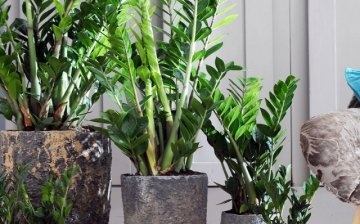
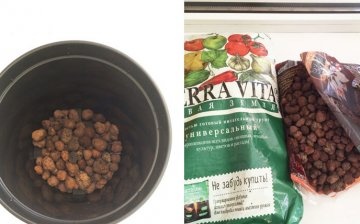
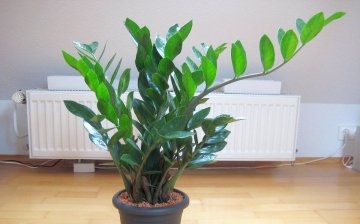
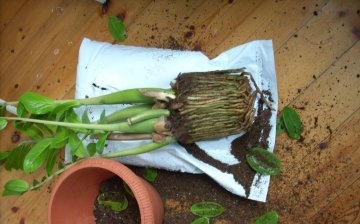
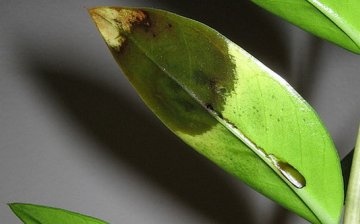









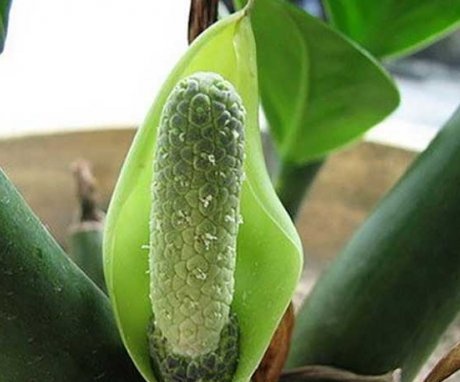
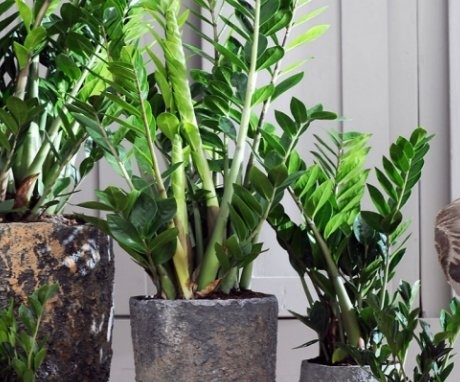

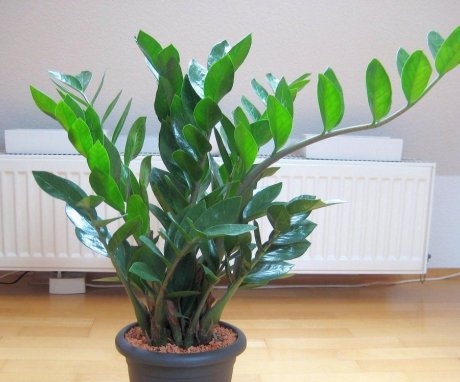
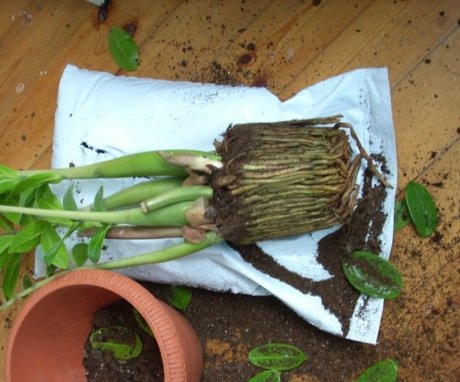
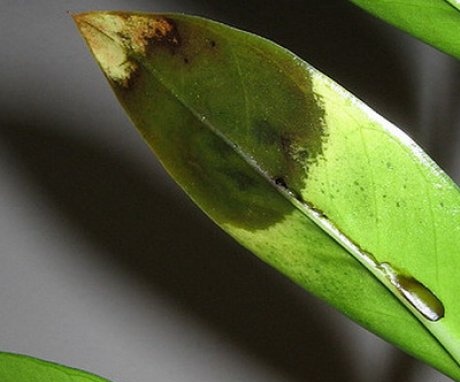
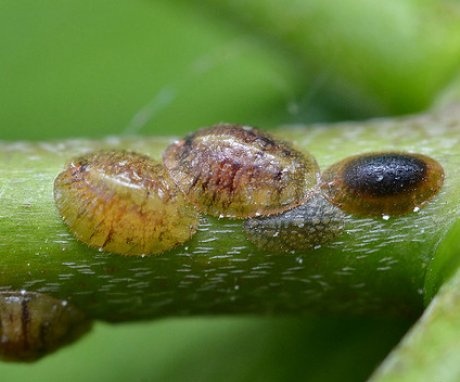
One of my favorites. A very unpretentious flower with gorgeous greenery, I water it very rarely, because it does not like an excess of moisture, it loves the sun, in the summer I take it to the balcony. The only thing has never bloomed yet.
Wonderful flower plant ...
It grows well in the office and develops well.
Tried twice when transplanting, "transplant" into another container, for another room.
And both times, for some reason, it does not take root. "Accepted", and then dries-withers.
Can we use the soil - "sick"?